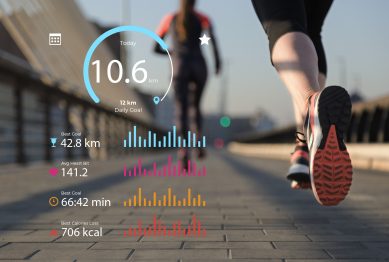In recent years, healthcare technology has shifted from the hospital to the wrist, finger, or even the clothing we wear. In 2025, innovations in healthcare wearables are not only transforming how people monitor their well-being but also redefining preventive care, chronic disease management, and clinical research.
From smartwatches that track heart rhythms to biosensors that measure glucose levels in real time, wearables are bridging the gap between personal wellness and medical-grade monitoring. As artificial intelligence, miniaturization, and connected ecosystems continue to advance, these devices are moving far beyond fitness tracking into the realm of predictive and personalized healthcare.

Why Healthcare Wearables Are Booming
Several factors are driving the rapid adoption of healthcare wearables:
- Aging populations: Longer lifespans mean more people are managing chronic diseases like diabetes and hypertension, requiring continuous monitoring.
- Rising healthcare costs: Preventive care through at-home monitoring helps reduce hospital visits and improve early intervention.
- Post-pandemic awareness: COVID-19 accelerated interest in remote health technologies and telemedicine, creating demand for accurate self-monitoring tools.
- AI and data integration: Machine learning allows wearables to analyze vast amounts of biometric data, offering insights that were once only possible in clinical settings.
According to Grand View Research, the global wearable medical device market is expected to surpass 180 billion by 2030, growing at a CAGR of nearly 28%. This expansion is being fueled by continuous breakthroughs in biosensing, battery efficiency, and wireless data sharing.
Emerging Trends in Healthcare Wearables
1. Continuous Glucose Monitoring for Everyone
Wearables for diabetes care are becoming more discreet and accessible. Continuous glucose monitors (CGMs), such as Abbott’s FreeStyle Libre and Dexcom’s G7, are shifting from specialized devices for diabetics to consumer-level wellness tools.
In 2024, Apple’s rumored development of non-invasive glucose tracking sparked significant attention. If realized, this would bring glucose monitoring to millions of smartwatch users, creating a new era in preventive nutrition and metabolic health.
Why it matters: Beyond diabetes, continuous glucose monitoring can help individuals understand how diet, exercise, and stress affect blood sugar levels, paving the way for personalized nutrition plans.
2. Wearables That Predict Cardiac Events
Cardiovascular disease remains the leading global cause of death, but wearable innovations are tackling this challenge head-on. Smartwatches like the Apple Watch and Samsung Galaxy Watch already include FDA-cleared ECG functionality, but the next generation of devices goes further.
Startups such as AliveCor and Withings are developing advanced sensors capable of detecting irregular heartbeats, atrial fibrillation, and even predicting the likelihood of cardiac arrest through AI-driven pattern recognition.
Practical example: A patient at risk for arrhythmia may receive real-time alerts through their wearable, prompting early intervention and potentially life-saving care.
3. Mental Health Monitoring and Stress Management
Mental health wearables are one of the fastest-growing categories in 2025. Devices now go beyond physical metrics, using biometrics like heart rate variability (HRV), skin temperature, and electrodermal activity (EDA) to track stress, anxiety, and sleep quality.
- Fitbit’s Sense series includes stress-tracking capabilities.
- WHOOP bands provide recovery and strain analysis to optimize rest.
- Muse headbands track brain activity to support mindfulness and meditation.
Why it matters: With rising awareness of mental health, these innovations offer early signals of burnout or anxiety, enabling users to adjust habits before issues escalate.
4. Smart Clothing and Skin Patches
Wearables are no longer limited to wristbands. Smart textiles and skin patches are emerging as comfortable, non-intrusive alternatives for continuous monitoring.
- Smart shirts with embedded ECG sensors track heart health during workouts.
- Electronic skin patches monitor hydration, electrolyte balance, and temperature.
- Pregnancy wearables embedded in clothing track fetal movement and maternal health.
These innovations allow medical-grade monitoring without bulky devices, making them attractive for athletes, patients, and everyday consumers.
5. AI-Powered Wearable Ecosystems
The future of healthcare wearables is not just about collecting data—it’s about interpreting it. Artificial intelligence enables wearables to provide actionable insights rather than raw numbers.
- AI-powered platforms can detect subtle changes in patterns, predicting illness before symptoms appear.
- Machine learning allows wearables to personalize recommendations, such as adjusting workout intensity or suggesting dietary modifications.
- Integration with electronic health records (EHRs) ensures data flows directly to healthcare providers, creating a seamless monitoring ecosystem.
This shift transforms wearables from passive trackers to proactive health partners.
6. Remote Patient Monitoring in Clinical Care
Hospitals and clinics are increasingly adopting wearables for remote patient monitoring (RPM). These programs allow doctors to track patients after surgery, manage chronic illnesses, and reduce readmission rates.
For example, the Mayo Clinic and Kaiser Permanente have launched initiatives where patients with conditions like heart failure use connected wearables to transmit data directly to their healthcare teams. This enables timely adjustments to treatment plans and improves outcomes while reducing hospital costs.
Practical Benefits of Healthcare Wearables
For individuals, adopting healthcare wearables offers several advantages:
- Preventive Health: Early detection of irregularities like high blood pressure or low oxygen saturation.
- Chronic Disease Management: Continuous monitoring for conditions such as diabetes, sleep apnea, and heart disease.
- Personalized Insights: Understanding how daily habits—exercise, nutrition, sleep—impact long-term health.
- Convenience: Access to medical-grade monitoring without repeated clinic visits.
- Empowerment: Data-driven decision-making encourages users to take control of their health journey.
For healthcare systems, these devices reduce the burden on hospitals, lower costs, and support a shift toward preventive care models.
Challenges and Considerations
While the potential is vast, innovations in healthcare wearables face challenges:
- Data privacy: Sensitive biometric data requires strict protection and compliance with regulations like HIPAA and GDPR.
- Accuracy: Not all consumer-grade wearables meet clinical standards, raising concerns about false positives or missed diagnoses.
- Accessibility: High costs may limit adoption in lower-income populations.
- Data overload: Without proper AI filtering, both users and doctors may struggle with excessive information.
Industry leaders are addressing these issues through stronger encryption, FDA oversight, and partnerships between wearable companies and healthcare providers.
The Future of Healthcare Wearables
Looking ahead, innovations in healthcare wearables will continue to push boundaries. Researchers are already exploring devices that:
- Detect early signs of neurodegenerative diseases like Alzheimer’s through subtle speech and movement patterns.
- Monitor blood chemistry through non-invasive sensors embedded in watches or clothing.
- Provide real-time hydration and nutrient tracking for athletes and older adults.
As wearables become more affordable and integrated into everyday life, they will play a critical role in global healthcare strategies. By shifting focus from treatment to prevention, these innovations could reshape how societies approach health and longevity.
Conclusion
In 2025, innovations in healthcare wearables are transforming the future of personalized health. From glucose monitoring and cardiac prediction to smart clothing and AI-powered insights, these devices are bridging the gap between consumer wellness and clinical care.
For individuals, healthcare wearables offer empowerment and convenience. For healthcare systems, they represent cost savings and improved patient outcomes. While challenges remain in accuracy, privacy, and accessibility, the trajectory is clear: wearables are becoming indispensable tools in modern medicine.
By combining technology, data science, and human-centered design, innovations in healthcare wearables are making personalized, preventive care more attainable than ever before.
References
- Wearable Medical Devices Market Size, https://www.fortunebusinessinsights.com
- Wearable Medical Devices Market Size, https://www.grandviewresearch.com
- What’s Inside Today’s Smart Medical Wearables? https://thebusinesslegacy.com









